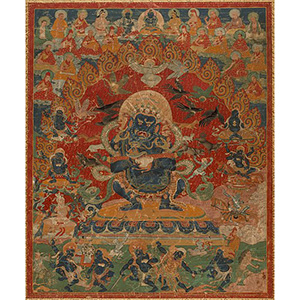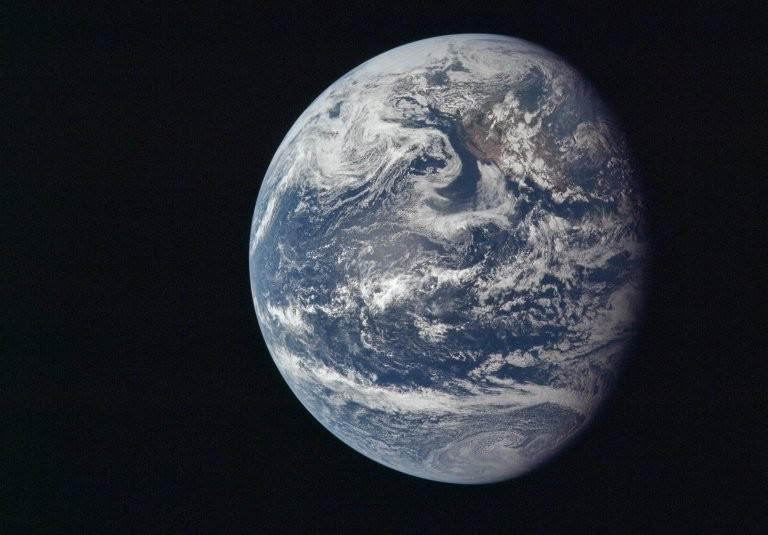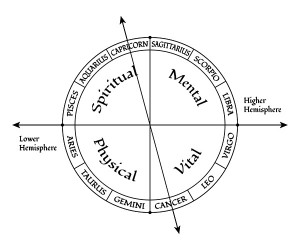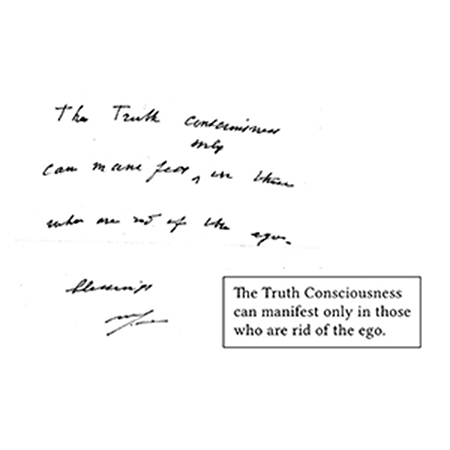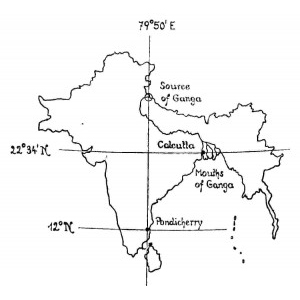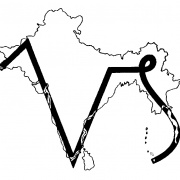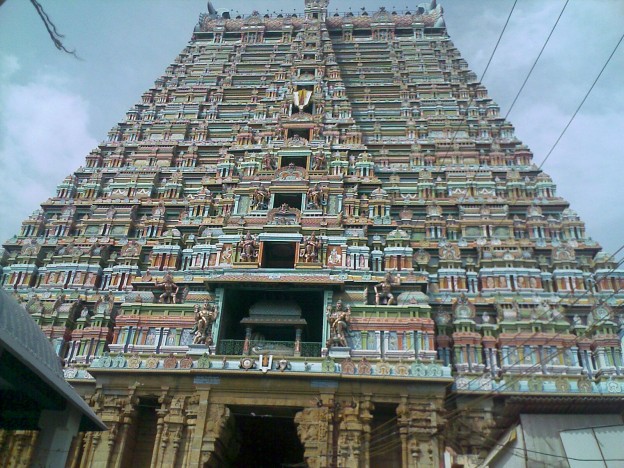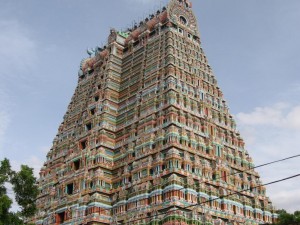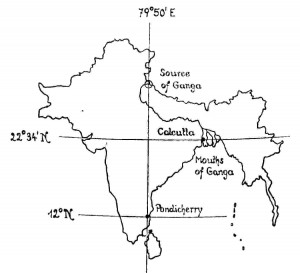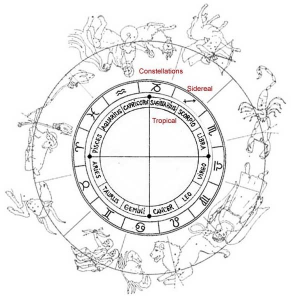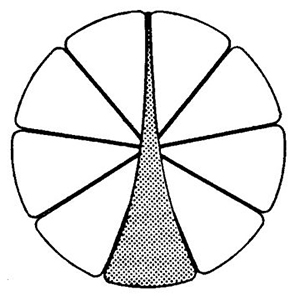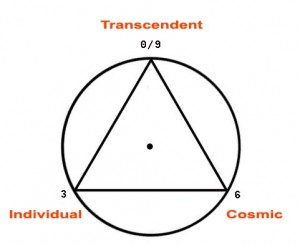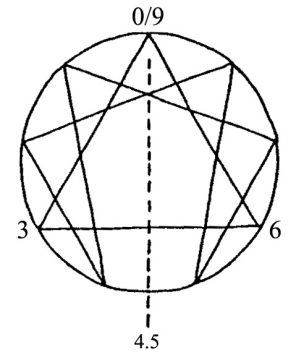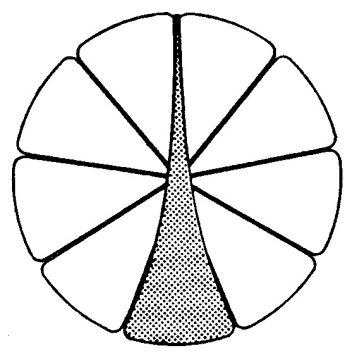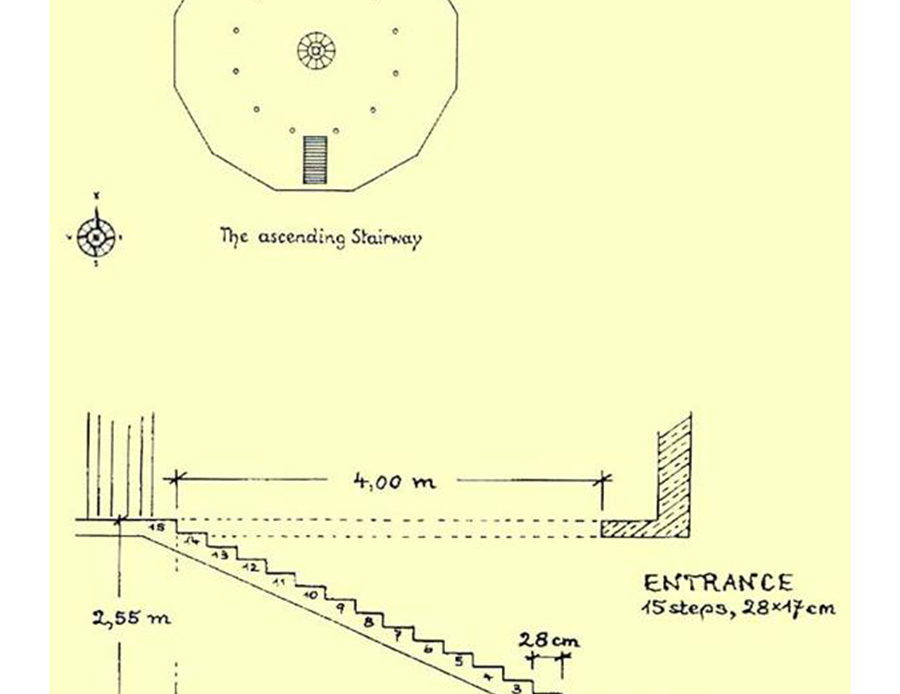Transcendence and the Imminence of the One, (originally published as Part I of Time & Imperishability, 1997)
‘The greater Form that thou hast seen is only for the rare highest souls. The gods themselves ever desire to look upon it. Nor can I be seen as thou hast seen Me by Veda, or austerities or gifts or sacrifices; it can be seen, known, entered into only by that bhakti which regards, adores andloves Me alone in all things.’Bhagavad Gita (XI, 52-54)
Thus spoke the Lord to the overwhelmed and trembling Arjuna, as he finally withdrew the supreme Vision of Himself. That Vision is indeed the one that must be sought if at all the secrets of birth and death and eventual rebirth are to become unveiled. Yet the Lord tells us in these verses that this seeing is only for ‘the rare highest souls’: the Mystery here revealed to Arjuna is the supreme Mystery for the human race.
From time immemorial the human spirit has been caught in the labyrinth of this universal enigma, but has never been allowed full entry into its central sanctum sanctorum. The Bhagavad Gita, one of India’s most profound scriptures, tells us that this is the highest truth, this is the truest perception that the seeker can aspire to in his or her lifetime, this is the Vision of visions. Though it is reserved only for the most intrepid, the Gita affirms for all times that it is Mahakala who holds the grandest truths. The Time-Spirit is the apex in the formidable pyramid constituted of the seemingly unending experiences that throughout the ages seekers have had of God.
Much has been written on the Bhagavad Gita, on its splendid philosophical content and moral injunctions, as well as those of its aspects which appear to be historic. But perhaps the seal put on its capital Vision as being unrealisable for most human beings, has indeed served to clothe the mystery of Time in ever denser veils. Throughout the ages seekers have thus fled from this vision and pursued a quest that, for all practical purposes, has led in the opposite direction. Over the past several millennia, spirituality has followed a path of otherworldliness, precisely because the seeing of Time presented apparently unsurmountable barriers. Though in India the most profound descriptions of the cosmos and the time mechanism have been preserved and handed down through the ages, ultimately the path enjoined upon the seeker has led beyond the cosmos. This reached a crucial juncture when finally the schools of Illusionism in all their shades arose and seemed to definitively capture the spirit of the nation. Thus, as for Arjuna, the vision of that highest Truth proved too demanding, too overwhelming, too devastating for the fragile human consciousness to contain. For to know Time is to know Death. If we are to see Kala, concurrently we must face Yama. The two are one and the same.
It is this factor that has kept seekers engaged elsewhere, yet they have nonetheless been caught by the paradoxes and perplexities of this perennial Mystery. For all paths seek liberation from life and death. Thus while fleeing from the embrace of Mahakala, the human spirit has nonetheless been engaged from time immemorial in discovering some sort of liberation from the awesome supremacy of this Great God, this Mahadev.
It is because of this failure, this inability of the fragile human spirit to sustain the vision and pursue the quest to its ultimate reaches that the mystery of life and death and consequently rebirth has remained impenetrable.
The crux of the matter lies in a penetrating and revealing perception of Time. No discussion of rebirth, in any of its aspects can be truly meaningful unless the question of time Is dealt with. Yet this is the most elusive aspect of universal existence, and in itself has occupied the investigative mind of not only spirituality but of science as well. All things born in time must die, we are conditioned to believe. Hence countless sages and saints and thinkers have encouraged seekers to accept a reality beyond Time as the ultimate liberation; for Time, in their experience, is the devourer and the destroyer and none can escape that noose of Yama. Yet the Lord revealed to Arjuna his highest form as precisely the Time-Spirit. Even the Puranas state that Time stands ‘above all the Gods.’ How then are we to reconcile this supreme Truth – for none lay in doubt the authority of the Scripture with the fact that sages and seers have encouraged seekers to pursue avenues which lead out of the cosmic manifestation, as if this creation were a hell from which, sooner or later, we must escape?
Time, however, that formidable Mahadev, is part and parcel of the cosmic reality in which we, as embodied consciousnesses, abide. Therefore the Gita tells us that this is the highest Knowledge, since as creatures born into this cosmic dimension, we have no other choice but to accept our condition of birth in the material creation and discover the true purpose of our embodiment. Indeed, the kernel of the pursuit lies precisely in the discovery of the purpose of birth in the cosmos, on Earth. The present tremendous unrest of humanity derives especially from the fact that the race has lost sight of its essential reason for being. It would seem that, like the vision of Mahakala which so tormented Arjuna, as a race we are being irretrievably thrust into those ‘mouths terrible with many tusks of destruction . . . faces like fires of Death and Time . . .‘ (XI, 25):
Destruction, doom and death are the powers that bar our entry into the heart of our quest, where the secret purpose of creation is held-into that cave where Guha, the veiled One, is concealed. This Son-God is the Child ‘hidden in the earth and the waters’ of our material creation, at the heart, the cave, of each embodied thing and being.
Mahakala is not only destruction, for the supreme Truth is a triune manifestation and every end initiates a new beginning. But for the process of destruction to be just one phase of an eternal mechanism, something must necessarily survive the devastation, something must remain ever unmoved, untouched, uncontaminated by the sting of death. The loss of the definitive knowledge of just what that imperishable core is, can safely be held as the reason for the enactment of the collective death-wish that presently plagues our society. Yes, the ancient truths live on, and their validity remains sublime in the eyes of all clear thinking beings. But these truths seem now to have lost their power to arrest or in some way to bring about a creative process in this devastating act of destruction which looms before us.
The problem is Time and Death. The failure is an inability to sustain the supreme Vision and penetrate into its deepest recesses so that we may come upon that Core and discover therein Guha, the Son-God, the child who holds that secret Purpose, who is himself Agni, the Immortal among mortals, the Immobile amidst the mobile.
How can we reach this magical Cave if we are ever fleeing from the vision and positing the apex of our quest in a Beyond, in an extra-cosmic dimension? This signifies a fleeing from Time, just as Arjuna was forced to do because of the delicacy of his temperament. However, today’s warrior – if he or she is to unravel the highest of enigmas and discover the deepest mysteries, which alone can give us that unique Sense once again-must face Time, must face Death, and thereby come upon the element in our being which survives destruction. Nay, which uses destruction as well as creation as the modes of its expression, as the vehicles upon which it moves in the world, immobile yet fully engaged in the mobility of this universe in an eternally renewing process.
This path lies in the opposite direction to the one seekers have been encouraged to pursue since the time of the Buddha. It lies in the core of creation, not in the Beyond, or whatever the name we give to this extra-cosmic reality.
A core must not only survive the action of disintegration; it must be the central pivot of the process, and even, we may add, its controlling element. It is that ‘centre that holds’, in contrast to Yeats’ vision of an apocalyptic disintegration due precisely to the fact ‘the centre cannot hold’, as he describes in his majestic verse. What then is this core? How does it arise, and moreover, how can it be experienced ?
These are the questions we shall endeavour to answer in this study. But first it is necessary to know the exact nature of the Reality we wish to explore, in the effort to clarify these fundamental questions. For the problem before us concerns our entire perception of the Absolute and our approach to that highest Reality. Indeed, a study of the development of spirituality and the course it has taken over the millennia is a precious aid in the knowledge we are seeking.
Undoubtedly all spiritual paths have led seekers to a Beyond, to a Transcendent Reality. Even religions have fostered the same emphasis. Some call it Heaven, others Nirvana. Whatever designation, it is evident that we are dealing with one avenue of experience; or, we may say, with one ultimate goal. This is by no means a false perception. It is deeply true, and for this very reason innumerable yogins and tapaswins have devised means to carry the aspirant to this static Beyond. Once one attains the capacity to place the consciousness out of the cosmic dimension, it is believed that one can enter into a transcendence which is an upholding or all-encompassing Consciousness that somehow, in some magical way, is not involved in the flux and flow of material creation and hence is untouched by the ravages of time and decay and death which appear to be the principal features of our universe. Methods of escape to this transcendent Brahman were thus devised in order to grant the troubled human spirit the solace of a peace that by virtue of its static quality could liberate the seeker from any further involvement in the torment of life and death. Rebirth, in this instance, was accepted only as a means to achieve this liberation ultimately. Unlike the mid-eastern religions that have arisen in this 9th Manifestation (beginning in 234 BC and lasting for 6,480 years thereafter), the pursuit of such an attainment was not limited to just one lifetime. Nonetheless, the goal was the same: a path out of the cosmos, hopefully never more to return.
The realisation such illumined beings attained cannot be denied or doubted. These yogins themselves stand as luminous beacons to the truth of the way and the goal. However, the time has come to view dispassionately such accomplishments in the light of our present discussion, insofar as the acquisition of a transcendent poise naturally suggests ultimate liberation from future birth. We are drawn to believe that the process of birth, death and rebirth, holds only as long as the human being is caught in the coils of the Ignorance. When finally he or she does attain liberation, concurrently with this accomplishment the realiser is freed from any further involvement with material creation and this ecstatic yet more often maddening Dance of Shiva.
However, the power of Arjuna’s vision still lingers in the consciousness of all who seriously pursue the path of Truth. That vision, if indeed it is the highest, presents a stark contrast to the static Beyond. And are we then not justified in questioning the content and direction of these ways which have not carried seekers to the truth of Mahakala but rather away from it? The conventional paths would have us believe that it is precisely a realisation or occupation with Time that is the inferior poise, and that the transcendent reality is the higher. But the Gita contradicts this notion, and it has held its place at the heart of Indian wisdom far longer and more persistently than any other scripture. It has thoroughly pervaded all Indian spirituality and captured the imagination of seekers for several millennia. But perhaps it is time itself that can give us the answers we seek.
Time is the great Controller. Thus if spirituality has moved in a direction opposite to Time’s mystery and truth, it must be Mahakala himself who is ‘responsible’ for the divergence We shall see anon how indeed this has been the case, when we bring into our discussion the line of the Ten Avatars of Hinduism. But for the present, it is important to discover the true nature of Reality, in its most limpid form. That is, we must ‘unmask’ the Transcendent itself, unveil it as we would unveil Guha, free it of the many elements which have diluted its pristine truth. At the same time certain fundamental aspects of that ultimate Beyond must be grasped, for only in this way can we appreciate without any illusions – our real condition in life and the material dimension.
The first aspect of the Transcendent that arises in our purview is its unmoving nature. That is, if indeed it is extra cosmic and represents something, some dimension, some plane of consciousness which from our poise within the cosmos we must view as ‘beyond’, then, given the fact that the principal feature of the cosmos is movement, it stands that in the Transcendent this element is withheld. We know therefore that one of the prime attributes of the extra-cosmic Absolute is that it is unmoving and immobile. This represents the great divide between Cosmos and the Transcendent Brahman. It is this immobility that has provided yogins with the exquisite experience of Peace. Extending the consciousness to the ultimate reaches of itself, all relatives in the universe dissolve into this great and immense static Calm.
If indeed the Transcendent is significant of that which lies beyond movement and the snare of the Gunas – creation, preservation and destruction – it is recognisable that this Ultimate Beyond does not suffer the fate of decay. For in such a condition, what can there be that is subject to decay? The process that engenders decay and death is irrevocably related to movement. The Transcendent being unmoving, It is understood that the next quality we discover is its imperishabiliy. The Transcendent does not perish because it is, in fact, unborn, – unborn in our moving and evolving universe. There is nothing of it that can be born and hence no experience of decay and death, much less of any rebirth.
Without a doubt the experience of that irrefutable imperishability is the single most enticing factor that has instigated the pursuit of realms beyond. At the same time, it is that devastating perception of disintegration that has established the vision of Mahakala as a prize for only those ‘rare highest souls’.
However, we approach now a third characteristic which has cast an element of paradoxical doubting into our quest and experience. It is this: If the Transcendent is unmoving and imperishable due to its other-worldliness, or its poise beyond and outside of the cosmos, then we encounter a particular aspect of its nature which has been the bed-rock of Indian spirituality from time immemorial. This is its indivisibility. Given the fact that it is a homogeneous Consciousness beyond the planes of existence in which division occurs, it stands that this Transcendent is hence indivisible. Consequent to this, we know that this perception offers the most compelling aspect of the Absolute: its unity, its oneness. Yet with this appreciation many of the paradoxes which face the human spirit arise; and due to this unity, oneness and indivisibility, it can be shown how until now no path has truly bridged the chasm that this experience of transcendent indivisibility and unity has created in our spiritual experience. And it is precisely because of this chasm that the highest Vision has been withheld from the seeker. For to bridge this intriguing chasm is to resolve the paradoxes.
The main aspect of the paradox is this: If the Transcendent or Static Brahman is indeed indivisible, then it stands that none of the experiences seekers have until now had of Its poise beyond and out of the moving cosmic dimension have been faithful to the truest and highest Truth. They have been real and overwhelming experiences, but they have suffered from a severe limitation. This limitation resides exclusively in the fact that any experience of the Transcendent which does not include the totally of Itself must be, to a certain extent, deceiving. For we cannot divide the indivisible. If the Transcendent is all-encompassing – and this is one of its most secure attributes – within Itself lies that which we consider irredeemably subject to division. The unity of the Transcendent carries us to the clear perception that the only true experience of Reality is an integral one. How then to achieve this perception of wholeness? and what would be its relation to the question of rebirth, the theme of our analysis?
It must be stated that this discovery is the key that unlocks those iron doors which do not permit entry into Mahakala’s sanctum sanctorum, and hence withhold from us the true meaning of life and death and our purpose in this material creation.
We cannot divide that which is lndivisible. This means then that there can be no true experience of those attributes that have been here enumerated of the Absolute which introduce the element of division.
Thus the Transcendent’s stasis can never be disconnected from its kinesis, a kinesis which in any case arises in its own Being. Likewise, its imperishability must contain within it the elements of all that is created, preserved and destroyed. But how is this accomplished?
The chasm is cleared of darkness and the bridge constructed in our awareness when we understand that the vast Transcendent in the act of manifestation is reduced to a seed. This is the profoundest mystery of creation. It is the origin of all things. The Unmanifest enters the Manifest (of Itself by virtue of this compression to a Seed, – that precious bija, that miraculous Hiranyaretas which is Agni. This Flame-Child stands at the Origin, he who is the first God extolled in the Veda. Thus all the attributes that we can conceive of in the Transcendent Beyond are drawn, by its own power of manifestation, into the Seed of Itself. That is, immobility, indivisibility, imperishability, are all properties which are contained in this miraculous Golden Bija.
What happens then to this Seed, which stands as the foundation of material creation?
The Golden Bija is the origin of spatial reality and the base of material creation. Manifestation (of the Unmanifest) results then in a central truth-seed, which from that Point extends itself, multiplies, grows, in the experience of creation, preservation and dissolution. This can be appreciated if we observe the nature of the cosmos we inhabit, which confirms this perception in that all its material bodies orbit a Centre. Indeed, centrality is one of the foremost aspects of the universal dimension. Yet there is a consciousness, a reality that extends beyond the material creation, or rather within which creation in matter is contained. But in appreciating this fact, a curious phenomenon took possession of the human mind. Somehow, along the way of human evolution the experience of God resulted in the fact that the Transcendent (the very significance of the word stands as a clue: that which lies beyond … ), which contains this universe in its Being and is all-encompassing, became veiled or masked to the perceptive eye of consciousness in the human being; and these contained dimensions came to be considered or seen as somehow inferior, or reflected an inferior spiritual poise and realisation, or a partial reality. This then reached its extremes in the formulation of the theories of Illusionism in all its many facets, and ultimately laid emphasis on an escape from these apparently inferior cages in which the human consciousness was seen to be imprisoned.
A divisive perception of this nature is not a property of the Divine Consciousness. It reflects a wholly human, mental poise and suffers from the scourge of a separative vision and experience, results of the mental orientation of the species. Because of this limitation of the present instrument, the Lord withdrew the vision of Himself as the Time-Spirit from Arjuna, since in this state it is not possible for humanity to attain a fuller and truer unified vision due to these limitations of the instrument and its subjugation to the rule of Mind.
The human species is an evolving collective entity. At present, civilisation as a whole is experiencing the pain of realising its limitations and insufficiencies and of knowing that as a race its actual constitution cannot permit a higher experience to come. To reach a wider and deeper collective experience, a new, more refined, more enhanced instrument is demanded. The turmoil of humanity at present is due largely to the fact that pressure is being applied on all quarters of Earth existence to compel the emergence of higher faculties so that a new way can manifest. Some details of this evolutionary process are given in Indian Scriptures. For example, in the Puranas we find mention of ‘the Nine Creations’. The final stages, the 7th, 8th and 9th, refer to the mental, the overmental and the supramental creations, respectively. Mental man is not the ultimate and highest but is merely a transitional creature. The evolutionary process, governed by the play of the tattwas and the gunas, is the mechanism to evolve a higher species. And one of the principal characteristics of this newly-emerging creation, superior to the present mental being, is a capacity to experience the indivisibility of God, – a consciousness, hence, of true unity. For this the being of the human experiencer must be fortified in such a way that it can withstand the impact of seeing the Time-Spirit working in the worlds, via the action of creation, preservation and destruction or dissolution, with an equanimity of being that arises from the knowledge of the Core-Purpose at the heart of material creation.
The Golden Seed contains this central truth. Our direct link with the Transcendent lies in this Seed, in the heart of ourselves and in the heart of our material universe. Thus to know that Purpose – the only real road to survival and salvation for the human species – one must plunge into the heart of matter and not away from it and into the Beyond. Since Time is inextricably linked with matter and material reality and cannot be seperated from the spatial, cosmic dimension, it becomes evident that to discover this truth and to embark upon this entirely new direction in our quest, we must realise God as presented to Arjuna in the supreme Vision he was granted of the Time-Spirit.
The Bhagavad Gita was the truth, the highest truth of the past Manifestation, the 8th. In this 9th Manifestation another way emerges, the way of Mahakala, carrying humanity to the threshold of the 9th and highest of the Puranic stages of creation. Central to this process, upholding it, controlling it, securing its inevitable, victorious fulfilment is that Golden Bija, – Hiranyaretas. Our experience of God must thus be in this Immanence; and the Seed contains the totality of that which is extra-cosmic. It is the Transcendent born in the manifest universe, it is the Eternal born in time, and there is no difference between the two. Rather we may say, this manifestation in matter presents an enhanced and more complete experience. The purpose of material creation is thus to express the fullest attributes of the Supreme Consciousness. Multiplicity is the truth of the cosmos, a splendid diversity whose reason for being is that all aspects of God can be given expression, that the Absolute can know Itself, can enjoy Itself. Self-knowledge and self-enjoyment are the propellants for deployment of the Absolute in material creation, in this great Dance of Shiva. The hierarchy that exists in the universe covers the entire range of such a self-knowing and self-enjoyment, resulting in the fact that at any given moment all possibilities of expression, of manifestation, exist simultaneously. For this is the nature of that Golden Seed: simultaneity and wholeness and compactness are its keywords. All is contained within the Seed.
And is there an end or a beginning to that Transcendent which stands beyond these distinctions? There can be no end to that which never had a beginning, which is ‘unborn’. Therefore, as all the other attributes of the Absolute are contained in the seed of Itself, so too is this supreme quality of ceaselessness and eternal manifestation.
Time’s function in the material universe is to draw the compact, involved elements held in the Seed to fruition. Time is thus the motor of Consciousness. It draws out and into extension that which arose at the Origin, at the moment of passage of the Unmanifest to the Manifest. This passage is the bridge connecting statics to dynamics. Time is movement, or rather it gives forth a body of itself in the cosmic principle of perpetual motion, or dynamic consciousness. Hence we encounter the splendid, colossal image in the Brihadaranyaka Upanishad of the universe in the form of a Horse, – that great and majestic Vedic symbol of energy, speed, kinesis. ‘Time’, the Upanishad tells us, ‘is the self of the horse sacrificial’. In this superb image the Seer describes the deepest truth of cosmic existence: that Time is the propeller and stands in the inner recesses of material creation and urges, propels it onward to completion, to fulfilment of its inherent purpose . . .’the self of the horse sacrificial . . .’
In this brief initial survey, which we shall carry to fuller dimensions in the course of this discussion, the first foundation of a new seeing arises: it is that the Transcendent and its immanent Seed, standing at the heart of material creation, are one and indivisible. The new faculty that will permit this simultaneous perception, will finally endow the human being with the capacity for a truly integrated seeing and experiencing of unity and multiplicity. For can there be any real existence of Unity without Multiplicity? Unity in itself implies the existence of the Multiple. A species is now to manifest which has evolved a faculty beyond Mind, capable of simultaneous appreciation of a unified multiplicity, which is the truer and more integral experience of God. Mind has been the aid as well as the stumbling-block until now. Mind has introduced division and hence has fostered a linear expression and divisive experience of Reality, and given rise in our civilisation to the fullest perversions and aberrations that ensue from this divisive, separative poise. The time has come to bridge the chasm and to make whole what has seemed to be severed only in or due to our perception, but not in the truth of Itself.
Hiranyaretas is a name of Agni. This mighty and adorable Vedic God’s vahana is the white Steed. Again we encounter here the image of motion and the energy that arises from intense speed, as in the blasting process of particles in nuclear physics. This image recalls the Upanishadic vision of the universe in the form of the Horse. Dynamics is then its essence (‘the self of the horse . . .’), but this is hardly the whole truth. For a chaotic and disintegrating and dispersed motion is not our experience of the universe, either spiritually or scientifically. Rather, what we see is a controlled and orderly movement, a harmony of the spheres, as it has been called from time immemorial. But what is the element that allows for this controlled and orderly dynamism, the truth of not only the cosmos but of our very own bodies? Once again we must delve deeply into the heart of the matter, to the innermost truth. We see then that ever and always centrality is the key. No matter how wide or how deep we extend our vision – that is, into the farthest reaches of the cosmos, or minutely focussed in the smallest of atomic particles – we find the existence of a core. That nucleus holds the body together – a body which is precisely characterised by motion – and controls and contains this play of colossal velocity, and secures a harmony and not a chaotic dispersal of energy.
In the human being we encounter this same truth. Each body is held together in life, in the experience of creative evolving, by a Core. Therein lies the seed of the Transcendent. It stands at the centre of our beings; and , as in the mighty universe, in the gigantic galaxies, this central core controls our existence in any given body and holds the key to our individual destiny. This is the ‘unborn’, the ‘undying’ part of ourselves. In the Veda this truth is expressed in the name of one of Agni’s vahanas: Aja, the ‘unborn’. Yet this word may prove deceiving because, accustomed as the human being is to separating reality into inferior and superior, higher and lower levels, when we use this term we fall prey to a consciousness that seeks escape from birth and the mechanism of evolution that has plagued seekers until now. We seem encouraged by such titles to seek dissolution into that unborn and undying One, for it alone appears to represent the highest truth which has somehow ‘fallen’ into this material hell and out of which it must emerge, never more to return. In such a case, birth, with all its glories and its travails, would clearly be a Divine jest, a farce played upon the human creation – and worse, played upon the Absolute Itself! Indeed, the final lines of the Rig Vedic Hymn of Creation seem to suggest just that: ‘He who in the highest empyrean surveys it, He alone knows, or else, even He knows not!’
Einstein has said God does not play dice, thus expressing his reticence in accepting the probability foundation of quantum physics. We can carry this a step further and state that the Supreme Consciousness does not know chaotic chance and purposelessness. Coupled with its indivisibility, the result is that birth in the material universe must not be in order to escape from it to the Beyond – for then, what was the need to enter this dimension at all? – but rather so that a fuller experience or expression of the Absolute could manifest. Material creation is thus the Body of Brahman, the Divine Shakti, deploying Herself for the purpose of the Absolute’s self-knowing and self-enjoying.
We cannot divorce ourselves from this truth and cosmic function. We are integral parts of the cosmic manifestation, minute as we may be in comparison to the vastnesses of the universe. However, does this minuteness not reflect then the very process of passage from the Unmanifest to the Manifest which has been described herein? We are, as it were, those very Seeds. We are those infinitesimal ‘eyes that see’ through which the Absolute knows, and thus knowing enjoys Itself. And this is the magic and the mystery of human birth. We are endowed with all the properties of the Transcendent and are Its instruments for this supreme Act of creative deployment of Itself.
How then can we desire to flee from this instrumentation, this glorious act of knowing along with God, of self-discovery of all the attributes contained within Itself ? But at the same time we must accept the Laws which govern the orderly deployment and extension in Time of the compact particles in the Seed. These use that majestic and awesome dynamism, the Power or the Shakti in her movement of creation, preservation and dissolution. To participate knowingly and willingly in this Act, we must then accept these laws – the essence of Time – indeed we must accept the Divine Mother. Thus we must evolve as a race beyond the capacity of an Arjuna and reach the point where we can know and sustain all aspects of Mahakala, above all his consort, Mahakali, without flinching, without seeking escape to the Beyond because of the limitations and trepidant condition of the present human spirit.
However, the aid for this realisation is indicated in the Gita. In the same verse the Lord gives this aid-key to Arjuna: Bhakti – but which ‘regards, adores and loves Me alone in all things’. Is this not the path we are describing in these pages? We see that the cosmic manifestation is the truth of that immanence, which results in the perception that Mahadeva is in all things. There is nothing outside of God, and the key for the method to sustain this highest of visions is Love.
This then brings our attention to focus on an aspect of creation which has held in rapt captivity the entire human race from the time of its inception. Nay, it is the truth encountered together with Time at the Origin. This is Love, – the power of Love. Because of Love a supreme equilibrium is secured in the material creation, which results in the fact that dissolution intoThat is rendered impossible. This harmony, this rhythm secures that a certain distance is maintained, a certain distinction and differentiation, whereby there comes into being a Knower and the Known, an Enjoyer and the Enjoyed, – the Divine Musician and the Instrument upon which and through which it can express Itself and enjoy that sublime Expression. If it were not for Love all would dissolve and never experience the bliss of Union, and material creation would then indeed be purposeless. It is Love that stands as the handmaiden, as the high priestess in the innermost temple in whose secret chamber we find Agni, the Divine Child, that superlative Purpose incarnate, that divine Will manifesting in the worlds.
Love holds all things in perfect harmony and equilibrium so that the Eye of Awareness can experience Oneness, can enjoy the bliss of that Divine Unity in creation. It is this that stands as the highest truth of our existence and being. Hence the Lord reveals to Arjuna that only such a bhakti, seeing, adoring, loving ‘Me alone in all things’ can be granted the vision of Mahakala; for indeed, Love and Time are the Being and Becoming of material creation.
Thus Desire, Love, the Ancients tell us was the first attribute or circumstance to arise in the being of That, and this was the link between the Unmanifest and the Manifest, between the uncreated and the created. Without hesitation it can be stated that this Rig Vedic Hymn of Creation is the most stupendous legacy left to human civilisation in the form of sacred texts. Nowhere in the vast collection of utterances on the Supreme Reality, do we find verses comparable to this one remarkable Hymn in that none can equal the truth-seeing of those illumined Vedic Seers. The most complete vision of creation, in its real and living truth, is expressed in this Hymn. To it we can turn for confirmation of our discoveries; and indeed it can be seen that if the path is followed into creation rather than away and out of it, perforce the result is the same as that of the Rig Vedic vision. No other scripture in the world has expressed so faithfully the cosmic truth as these collections of Songs in praise of the Divinity, – indeed, the most ancient record of truth-seeing the world possesses.
At first there was the Pulse of the One, alone. Then arose love, Desire, for that drew the Pulse into extension, into manifestation. Everafter it journeys to the discovery of Self, to the expression in the womb of material creation of the harmonies of that Pulse of the One. Love drives the One onward, outward in its quest for completion, for fulfilment, for apotheosis of the inherent truth of Itself. Thus Love is the essential power of this material universe, and these same longings are planted in the breasts of all living creatures, propelling them onward ever in search of that pulsating One in the Core in the primordial Hiranyagarbha. For out of this Golden Womb, or rather contained within it, are the Golden Seeds. Womb and Seed are thus the secretmost truths of material creation and hence the deepest truths of human existence itself. The propagation of the species is ever a reproduction on dense levels in that great and dark original Plasma, of this primordial act of Creation.
How could the ancient Seers know this Act so thoroughly? Did they look out, beyond, into the Absolute Transcendent? Nay, such a seeing, as experienced by these ancient Rishis, came through the depths of the soul. Therein womb and seed are lodged. This is the Cave, and in it are concealed all the secrets of creation, of the truth of our world, our lives, our destiny, our rebirths.
Desire drew out that which lay compact, contracted into ‘That One . . . there was nothing else nor ought beyond it’ . . . And with desire, out of the depths of Love, came ‘will in the heart’, and this then ‘extended horizontally’ that Ray. Thereafter the seed of Brahman was cast far and wide in the process of self-manifestation, from self-law. And thus the Pulse gave birth to the worlds and all creatures therein in an eternal process of creation, preservation and dissolution.
But at the heart of It all stands a Core, in the immense Core of the One Itself. Thus as embodied beings our profoundest truth is this central cave in which That One resides, at the innermost heart of ourselves. It can be visualised as a formidable tornado in whose centre stands an eye. The colossal play in the periphery is united and one with the centre. Indeed it cannot exist divorced from this essential unity. It is the same for each human incarnation. What is it that is born? The Vedic Hymn of Creation tells us exactly what this is, how birth comes about. The process of the greater manifestation is the same for the smaller, just as the infinitesimal atom reproduces in the minute boundaries of itself the same phenomenon and conglomeration of matter that we can perceive in the gigantic universe. Millions upon millions of ‘galaxies’ we carry in our human bodies. Each has a centre with its core or nucleus, and these ‘galaxies’ are held together by a ‘galactic centre’ in the human body, which is the soul.
Like the centre of our galaxy or the centre of our solar system, a luminous ‘sun’ abides in our hearts. That ‘seed’ is the centre in its inner circumference, – a magnetic core which by the special properties inherent in its central Pulse, is able to hold in orbit all the galaxy-cells of our bodies. In the course of our lives a ‘ray’ is extended horizontally from this vertically compressed seed, as the Rig Veda describes, from this point outward. And this extension is the lived (horizontal) experience of our individual Time, by which means we serve as conscious instruments in creation for the supreme act of self-knowing and self-enjoyment of the Absolute.
The core moves from one dimension to another. It is our bridge to the other hemisphere, to what is for us, in our state of unawareness, the unknown. The gateway to that unknown is Death. Passage to that other side signifies a rupture of the horizontal extension of our individual time. However, this is simply the result of the limitation of the present human instrument, in which and for which this core is entirely veiled. Guha remains ever concealed for most if not all human beings. Yet, what does indeed happen at death in all individual existence? What does it mean to say that time ceases for a person who dies, which is an obvious fact and cannot be denied? It appears that with human birth we enter the realm of time. We thus begin our journey on this crushing wheel that characterises the universe in which we exist, only then at death to be mercilessly thrust out of its womb of relatedness and relativities into some void, from whence it seems we have come, to be finally disentangled from all the relations and experiences nurtured, cherished (or even despised) in the process of living in time on this planet, in this universe. What is the purpose of this painful severance that death afflicts upon almost all human creatures? Or else, in order to escape from this anguish that birth invariably sets in motion and the suffering engendered by a life in ignorance, one seeks the refuge of death in order that these knotted relations in this great web of our time-pattern cease to exist and bind us to this awesome yet horrific Wheel, our benediction and our bane. It seems the only salvation possible is therefore to use Death as a means to liberate ourselves from a continued existence in the material universe and on this particular planet. Death then appears to bring an end to all relatedness. Where time exists there is an unavoidable web, constituted of experiences lived in material creation, but held together by a core. There can be no such construction on the basis of relations in the universe, between its myriad parts, unless a core central to the process exists.
In our exploration we have seen that this core is the compact, contracted, unextended and compressed essence of the Absolute. All true centres carry this magnetic Pulse within their spaceless dimensions. Because of the existence of this central Point, the process of extension by and through time can ensue and material manifest being arises. Time is thus the principle energy of creation, the ‘self’ indeed of that mighty cosmic Horse. Yet for this play to ensue, the ‘centre must hold’. And it does hold. Every human birth, not to speak of the universe itself, stands as testimony to the existence of this One.
In our innermost core That One is lodged. This is Agni, the divine Fire. It is the incarnate Will. The ‘pulse’ that arises at the origin of Time is that Will. Thereafter it sends out its reverberations. These then produce ripples in the fabric of our individualised ‘systems’, which then become that web we inhabit, just as a spider from her own being, her centre, draws forth the substance which she uses to construct her web, the ‘cosmos’ she then inhabits. Essential to this process is Desire, or the Power of Love, which results in a harmony of all the parts by virtue of the fact that it secures the indispensable ‘distance’ in order that the process of separation can allow for an Enjoyer and the Enjoyed.
In that core there is no relatedness, for this requires extension. There is only Being, truth of being, Sat. Yet without the core no relations could come into existence, for they cannot arise without a binding centre, a hub as it were. Likewise, the attributes of the core could never ‘know’ themselves if divorced from the full process of manifestation. And holding this majestic Play together, in a magical balance of contraction and expansion, is that magnetic Point. Indeed this Seed is equal to the Absolute. One is the vast; the other is the minute and compact. Thus in our individual core we hold this golden Bija containing all the attributes of the Transcendent.
Imperishability is its nature. How then can this Seed-Core die if essential to its being is eternal ceaselessness? But indeed it does not perish. At death it is time that ceases (to our conscious experience). And this brings the pain of separation from all that during the conscious passage of time in our bodies we had come to cherish and to love. This pain of separation has been the scourge of human existence, this knowledge that all things born must die, that no matter how fulfilling and satisfying our lives, whatever is built up in this individual yet multiply-interrelated web must dissolve at death. There is no way in which we can carry anything with us into that beyond, that unknown realm. Hence a sense of purposelessness permeates the entire fabric of individual and collective existence. The human creature seeks desperately to overcome this apparent purposelessness of life through what appear to be creative acts, resulting in some carried-over element, be this a work of art, of literature, of science, or whatever; or else simply in the extension of his seed in the form of his offspring. But the pain remains. The unknowing continues to plague us all. And we seek compensation or extinction.
The answer sages have given is to establish a poise of consciousness that rests on the solid realisation of uninvolvement and detachment. Yet this, as mentioned, merely serves to confound the already impossible confusion death generates for the troubled human spirit. That is, such a realisation, as exhilarating as it may be, merely serves to put a Divine Seal on purposelessness. We are then entirely justified in viewing the world in which we live as void of any great or even minor sense. For all practical purposes it is a maya, an illusion, a web whose centre is a sombre void.
However, in that core there is no void but rather plenitude of Being, and therein lies the secret dharma which is our eternal truth of being. In it we find that great Purpose, individually and collectively, and we realise that birth is a supreme grace, for it grants us the opportunity of conscious enactment of that very Purpose. Nonetheless, we are faced with the experience of death. No matter how solid the equanimity of our consciousness, we must still deal with Yama and Kala when ‘our time is up’.
Death brings oblivion. In that Sleep of sleeps we are disengaged from all that we had experienced in life on this side. However, is this a permanent feature of life? Or is it simply the result of our present constitution? Together with this query goes another, and they cannot be separated: Is this creation thus essentially one of Ignorance? For this is our experience of it as human beings who live life bounded by the limited vision of separateness and disunity. Thus we have devised countless theories to fortify our ignorant experience and justify our behavior patterns which are tearing civilisation to shreds; or else these theories serve to justify our quest for a Beyond in isolation from and severed from this manifest world of relatedness.
The cloak of Ignorance that presently shrouds human consciousness is the sole purpose for the imperative need of oblivion at the time of death, in order that we continue our instrumentation, drawn back into life by desire of fulfilment, so that we may continue as individualised ‘eyes that see’.
When we take birth – and the process of birth extends beyond the boundaries we attribute to it in the 9-month gestation process starting with conception – we set in motion that magical process of the Eye of the Tornado gathering energy about itself. We collect, on the basis of this eye-core, the elements or sheaths or bodies which are necessary for the extension in matter of that One in the Core. We form our vahana, or vehicle. This element, which is an individualised seed-truth of the Absolute, is the particle that survives all death, disintegration and rebirth – but that uses the tattwas and the gunas for its mechanism of expression in the most material dimension. It collects energies, organises them, creates a cosmos of the chaos – so perfectly conveyed in the Vedic term, ritam. This is the Undying, the Unborn one Aja, the mighty vahana of Agni; for this symbol describes the ‘body’ of the essence that Agni is. He is the first of the Gods and the realiser of immortality; or rather, that Immortal among mortals. Agni is that One, that Pulse in the Core, that Hiranyaretas, or the Golden Seed. Indeed, the Immortal amongst the mortality of our decaying parts.
This Core is undying. It does not decay. It knows and enjoys ceaselessness, eternal Becoming, an action which by virtue of its Being is controlled and ordered and expressive of the highest Truth. This is our own inherent truth, our intrinsic Dharma, collectively and individually. In view of this luminous destiny, whence this pain and the affliction of an ignorant unknowing, which seeks to avoid birth and flee from the Cosmic Womb of the Mother, as one would flee from the darkest Hell?
Again it must be stated that knowledge of the reality of this material creation and hence our own participation therein as conscient beings can only come by a plunge into that Core and not away and into any Beyond. It is also this plunge ‘Into the Seed-Core that can give us any real and lasting satisfaction in the quest for true knowledge of rebirth, as well as of birth itself, and that ever enigmatic, terrifying, rapacious ‘hunger that is Death’.
© Patrizia Norelli-Bachelet, 1997

